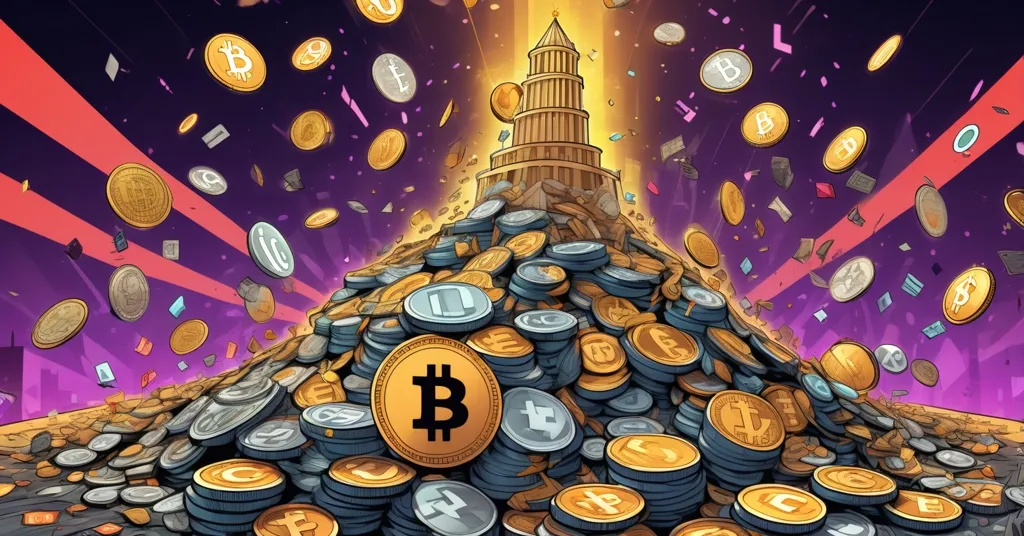Crypto Hype vs. Reality: YZY & MELANIA Flop, While XYZVerse ICO Shows Promise

Crypto Hype vs. Substance: Why YZY and MELANIA Crash While ICOs Like XYZVerse Hold Promise
Celebrity names and viral tweets can send crypto tokens soaring overnight, but the inevitable crashes often leave retail investors holding the bag. From Kanye West’s YZY token imploding after a meteoric rise to politically charged meme coins like MELANIA following the same pump-and-dump playbook, the crypto space is a graveyard of hype-driven disasters. Yet, amidst the wreckage, structured Initial Coin Offerings (ICOs) like XYZVerse ($XYZ) are carving a different path, betting on transparency and planning over fleeting buzz.
- YZY Collapse: Hit a reported $410 million market cap in under an hour, only to crash 70% to $140 million within a day.
- Political Token Scams: Coins like $LIBRA, $TRUMP, and $MELANIA exploit trust with cultural ties, leading to massive investor losses.
- XYZVerse Potential: Raised over $15 million in presale with a structured approach, aiming for a 1,000x return at listing.
The Hype Trap: Celebrity Meme Coins Unraveled
Let’s start with the ugly reality of celebrity meme coins, and there’s no better case study than YZY, tied to Kanye West (or Ye, depending on the day). This token skyrocketed to a staggering market cap—reported as $410 million by some sources, though others claim a peak as high as $3 billion—in mere minutes, fueled by social media mania and the sheen of a superstar’s name. But the ride down was brutal. Within the same day, YZY tanked 70% to around $140 million, obliterating the portfolios of countless retail investors who jumped in at the top. On-chain data from Solana explorers reveals a damning truth: a handful of wallets control upwards of 80-94% of the supply, a glaring red flag for insider manipulation and dumps as highlighted in reports on YZY’s crash. Questions linger about Kanye’s role—did he endorse it, or was his image exploited? Either way, the fallout speaks for itself.
YZY didn’t just crash, it imploded under suspicion, proving a headline and a hype tweet can launch memecoins, but can also crater them before most people even realize what hit them.
For those new to the space, a meme coin is typically a cryptocurrency inspired by internet culture, often lacking serious utility but riding waves of viral attention. When paired with a celebrity name, the hype can be explosive—but so can the losses. YZY isn’t a one-off trainwreck. The crypto market has been flooded with similar tokens since 2021, especially on fast, cheap blockchains like Solana. Think Caitlyn Jenner’s JENNER token or Jason Derulo’s JASON, both of which saw massive pumps followed by gut-wrenching dumps. These projects thrive on FOMO—Fear of Missing Out—driving naive investors to ape in without a second thought. But with no roadmap, no real use case, and often no transparency, they’re little more than gambling chips for the Twitter hype machine, as explored in discussions on why celebrity meme coins often fail.
Political Tokens: A Predator’s Playground
The scam doesn’t stop at celebrity tokens. Politically themed meme coins like $LIBRA (tied to Argentina’s economic struggles), $TRUMP, and $MELANIA follow a near-identical script: a burst of excitement, a false sense of legitimacy through cultural or political narratives, and then a vicious collapse. $LIBRA, for instance, cost investors hundreds of millions as it unraveled under scandal. Dig into the backstory, and you’ll find recurring names like Hayden Mark Davis, a serial scammer allegedly orchestrating rug pulls across multiple political tokens, including $TRUMP and $MELANIA, with evidence of these schemes shared widely online. These aren’t just lousy investments; they’re predatory traps designed to exploit trust and emotion.
A “rug pull,” for the uninitiated, is a scam where project insiders or developers hype a token, inflate its price, then sell off their massive holdings and vanish, leaving everyone else with worthless assets. It’s the seedy side of decentralized finance (DeFi), where the absence of regulation lets bad actors run wild. Political meme coins are especially ripe for this, as they prey on ideological fervor or national pride to mask their lack of substance, a trend further discussed in community critiques of YZY and MELANIA scams. Compare this to Bitcoin, the pioneer of crypto, which—despite its ups and downs—stands as a decentralized store of value with a clear purpose: a middle finger to centralized banking and inflation. Even Ethereum, often knocked by Bitcoin maximalists like myself for its complexity, brings real utility with smart contracts and decentralized apps (dApps). These political tokens? They’re pure noise, built to fleece the hopeful.
Crypto isn’t falling for it anymore. The crowd is too sharp, too burned, too battle-hardened to ape into ‘celebrity rug 15.0’.
Structured ICOs: A Glimmer of Hope?
Before we write off the entire meme coin space as a cesspool, let’s look at the flipside. Not every project is a YZY-style disaster waiting to happen. Take XYZVerse ($XYZ), a meme coin that’s raised over $15 million in presale by focusing on structure rather than empty buzz. Starting at $0.0001, its token price has climbed to $0.0053—a 53x return for early backers. Their roadmap targets a listing price of $0.10, which would mean a potential 1,000x gain from the initial presale, with post-launch projections of $0.15–$0.25, though the Token Generation Event (TGE) isn’t until the second half of 2025. Unlike celebrity coins, $XYZ emphasizes transparent tokenomics, locked liquidity, and community-driven growth, with details available on their official platform.
Let’s break down some of these terms for clarity. Tokenomics refers to the economic model behind a token—how its supply is managed, how it’s distributed among holders, and what incentives keep the project alive. Good tokenomics can mean the difference between a sustainable coin and a rug pull. Locked liquidity, meanwhile, means a chunk of the project’s funds is secured in a way that prevents insiders from cashing out early and tanking the price—a safety net of sorts for investors. $XYZ also boasts audited smart contracts and KYC (Know Your Customer) verification, alongside phased presale stages to build trust organically. Their approach includes buybacks—where the project repurchases its own tokens to potentially boost value—and burns, which permanently remove tokens from circulation to reduce supply and possibly increase price, as analyzed in an in-depth look at XYZVerse’s ICO potential.
Structured presales and ICO-style launches still carry something hype coins don’t: a path to trust. A way to grow holders organically. A plan.
An Initial Coin Offering, or ICO, is essentially a crypto crowdfunding method where a project sells tokens to early investors before hitting public exchanges. Think of it as a high-stakes Kickstarter. Back in 2017, ICOs were notorious for scams, but today’s stronger projects aim for accountability. $XYZ stands out in this regard compared to the chaotic launches of other meme coins like TOKEN6900 (a $2.3 million presale darling with 50x buzz) or Maxi Doge (offering 213% APY staking). Even against tech-driven contenders like MemeCore with its Layer-1 blockchain, $XYZ’s focus on fundamentals over flash feels refreshing, especially when contrasted with broader trends in meme coin hype versus substance.
The Bitcoin Maxi Lens: Where Do We Stand?
As a Bitcoin maximalist, I’ll always argue that BTC is the unassailable fortress of decentralization—the digital gold that doesn’t need gimmicks or celebrity endorsements to prove its worth. Its network security, proven track record, and ethos of disrupting centralized power make it the backbone of this financial revolution. I’m skeptical of altcoins and meme coins by default, but I’m not blind to the niches they fill. Ethereum powers DeFi and NFTs; Solana’s speed enables dirt-cheap token launches (for better or worse). Meme coins like $XYZ can capture cultural moments and onboard new users in ways Bitcoin never will—nor should. They’re often the gateway to decentralization, even if 99% of them are garbage. The challenge is filtering out the scams from the experiments worth watching, a point underscored in analyses like why hype alone isn’t enough for tokens like YZY.
That said, let’s keep the rose-colored glasses off. A 1,000x return sounds enticing, but crypto is a savage game. Even structured ICOs can flop under bear market pressure or if execution falters post-launch. History is littered with promising projects—think Bitconnect—that crumbled despite polished plans. $XYZ’s delayed TGE until 2025 and ambitious price targets raise eyebrows; overpromising is a red flag in itself. Plus, the broader meme coin space remains a minefield. For every Dogecoin that peaked at $60 billion, there are thousands of YZYs ready to burn the naive, with detailed accounts of such failures documented on platforms like YZY Token’s crash history. And regulatory risks loom large—celebrity tokens are already under SEC scrutiny for undisclosed promotions (look at Kim Kardashian’s EthereumMax fiasco), and that net could snag others. The market is maturing, but it’s still a playground for the reckless.
Celebrity coins are collapsing under their own hype. Today’s market demands structure, not noise—and only well-built meme coins have any shot at real returns.
Key Questions and Takeaways for Crypto Enthusiasts
- What drives the rapid rise and fall of celebrity meme coins like YZY?
Viral hype and big names fuel explosive pumps, but with no utility or transparency, insider dumps trigger inevitable crashes, leaving retail investors rekt. - Why are political meme coins like $MELANIA particularly risky?
They exploit trust by mimicking legitimacy through political narratives, often hiding insider control and rug-pull schemes designed for quick, dirty profits. - How does XYZVerse differ from hype-driven tokens?
It leans on a structured ICO model with transparent tokenomics, locked liquidity, and a community-focused roadmap, prioritizing substance over celebrity sizzle. - Is a 1,000x return realistic for structured ICOs like $XYZ in today’s market?
It’s possible, as $XYZ’s 53x presale gain and $0.10 listing target suggest, but post-launch execution, market conditions, and regulatory hurdles are massive variables. - What lessons should the crypto community learn from recurring rug pulls?
Due diligence is everything—prioritize projects with clear plans and verifiable transparency, and resist FOMO around unverified hype, no matter who’s tweeting.
So, where does this leave us in the wild west of crypto? Hype is a potent drug, but it wears off fast. YZY, MELANIA, and their kind are harsh reminders that a famous name or political spin isn’t a golden ticket—it’s often a neon warning sign. Meanwhile, projects like XYZVerse are wagering on structure over spectacle, aiming to rebuild trust in a space that’s been torched by scams. As advocates for decentralization, privacy, and shaking up the status quo, we should cheer for these experiments to succeed, even if we clutch our Bitcoin with an iron grip. But let’s be real—whether it’s a rug pull or a rocket, crypto is high-stakes gambling. Stack your sats, do your homework, and if you take a punt on the next big thing, don’t bet more than you can afford to lose. The game’s brutal, but for those who play it smart, the upside is worth the fight.



